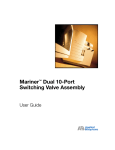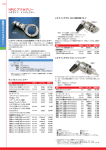Download Operating Instructions
Transcript
Operating Instructions ® Models 7725(i), 9725(i), 3725(i)-038, 3725(i), and 9125 Manual Sample Injector 1.0 DESCRIPTION Models 7725(i), 9725(i), 3725(i)-038, 3725(i), and 9125 are six-port sample injection valves in which the sample is loaded through a built-in needle port in the front of the valve. Models 7725(i) and 3725(i)-038 are the stainless steel versions, and Models 9725(i), 3725(i), and 9125 are the PEEK versions. Models 3725(i)-038 and 3725(i) are preparative scale sample injectors that accept 1/8" fittings. Preparative scale sample injectors are identical to their analytical scale counterparts, but perform preparative scale applications. The "i" version of each model includes a built-in position sensing switch. Refer to Section 10.3 for details on the position sensing switch. Figure 1 shows the flow diagram of the valves (Model 9125 does not contain MBB valve design shown as the dotted flow passage). The circles represent the ports in the valve stator. The dark grooves represent the connecting passages in the rotor seal. The dotted flow passage represents the Shaft End Rotor Seal Stator Face Stator Rotor Seal Groove Stator Face Seal MBB Passage Column Pump MBB Passage Fig. 2. Cut-away view of MBB design. Make-Before-Break (MBB) valve design. A detailed cut-away view of the MBB design is shown in Figure 2. The sample loop is loaded through the needle port in the LOAD position. Rotation of the handle 60°, switches the valve from LOAD to INJECT. In INJECT the mobile phase and sample flows through the loop and onto the column. The MBB valve architecture allows uninterrupted flow as the valve switches from LOAD to INJECT. The mobile phase continuously flows through both the rotor seal groove and the MBB passage until rotation stops. See Figures 1 and 2. I Sample Loop 1 Waste 6 2 Pump Waste 5 MBB Passage in stator face seal 4 3 MBB hole connects MBB passage to front side of stator face Needle Port Column Position 1 (LOAD) Sample Loop Pump 1 6 2 Column Waste 5 3 4 Waste Needle Port Position 2 (INJECT) Fig. 1. Flow diagram of sample injectors with MBB design. Model 9125 has the same valve design without MBB. There is a 2 µL internal sample loop (P/N 7755-015) available for Models 7725(i) and 9725(i). The internal loop can be installed inside the injector, in place of the standard stator face assembly. 2.0 SUPPLIED WITH THE VALVE Supplied with the valve in a separate bag are fittings sets for all ports and the items listed below. A 20 µL sample loop is standard with the 7725(i), 9725(i), and 9125. A 10 mL sample loop is standard with Models 3725(i)-038 and 3725(i). • 1/4-5/16 Wrench (3725(i)-038 and 3725(i) only) • 9/64 Hex Key • 5/64 Hex Key • Needle Port Cleaner • Mounting Screws • Vent Tubes For Models 7725(i), 9725(i), and 9125, the #22 gauge needle supplied in the valve should be removed from the needle port before using these injectors. A #16 gauge needle and a plug for the needle port are supplied with Models 3725(i)-038 and 3725(i). The plug should be removed from the needle port when loading the injector. See Warning 4.1. Page 1 of 4 2320607E 12/10 3.0 SPECIFICATIONS Table I. Valve Specifications. Valve Maximum Temperature (°C) Maximum Pressure [MPa (bar, psi)] Flow Passage Diameters [mm (inches)] 7725(i) 80 9725(i) 50 34 (345, 5000) 3725(i)-038 50 34 (345, 5000) 0.3 (0.013) & 0.5 (0.018) 9125 50 34 (345, 5000) 3725(i) 50 48 (483, 7000) 28 (276, 4000) 4.0 IMPORTANT SAFETY NOTICES 4.1 Warning (for 3725(i)-038 and 3725(i) only): Use the needle port plug attached to the handle assembly to shield yourself from mobile phase coming out of the needle port when the valve is turned from INJECT to LOAD (see Figure 3). 4.2 Warning (for 7725(i), 9725(i), and 9125 only): When using sample loops larger than 100 µL, shield yourself from mobile phase coming out of the needle port when the valve is turned from INJECT to LOAD. Example: 1 mL loop ejects 20 µL upon decompression from 19 MPa (200 bar, 2898 psi). Locking Pin Plug Fig. 3. Using the needle port plug. 4.3 Warning: When using the Needle Port Cleaner, empty the syringe slowly to prevent solvent from squirting back at you. 4.4 Caution: When using the PEEK valve use only RheFlex® PEEK fittings sets in the stator ports. Metal ferrules can cause irreparable damage to the plastic stator. 4.5 Caution: Rinse the valve with water after using buffer solutions to prevent crystals from forming, which can cause scratches on the rotor seal. 4.6 Caution: Due to the 30° ports, sample loops for Models 7725/7725i are not interchangeable with loops of many other stainless steel Rheodyne valves. 5.0 USING PROPER SYRINGES For Models 7725(i), 9725(i), and 9125, use syringes with #22 gauge syringe needle, without electrotaper and with 90° point style (square cut). 0.6 (0.024) & 0.5 (0.018) Wetted Surfaces 316 stainless steel, alumina ceramic, and an inert polymer PEEK, alumina ceramic, and an inert polymer 1.0 (0.040) 316 stainless steel and PEEK 0.3 (0.013) & 0.5 (0.018) PEEK, alumina ceramic, and an inert polymer 1.0 (0.040) PEEK For Models 3725(i)-038 and 3725(i), use syringes with #16 gauge syringe needle, without electrotaper and with 90° point style (square cut). Using the incorrect needle size will damage the injector. 6.0 INSTALLATION a) To mount the valve on a panel, remove the handle by loosening the two handle set screws. Use the two screws supplied to fasten the valve to a panel. b) Confirm that the handle protrusions are out of the slots in the pressure adjusting screw. Replace the handle by tightening the two set screws on the two flats of the shaft. c) See Caution 4.4. Connect the two vent tubes (supplied) to Ports 5 and 6. Place the outlet ends of both at the same horizontal level as that of the needle port to avoid siphoning. See Figure 4. d) Connect the pump to Port 2 and the column line to Port 3. Leave the column disconnected from the valve during initial flushing. 7.0 FLUSHING THE INJECTOR In INJECT, flush the needle port with 1 mL of mobile phase, using the Needle Port Cleaner as shown in Figure 5. At this time, the pump flushes the loop. CAUTION: To avoid liquid squirting back at you, discharge syringe slowly. 8.0 MAKING AN INJECTION There are two common methods of loading the sample loop – complete or partial filling. A third method is loading by suction (Section 8.3), which is for loading the PEEK valve when you want to avoid contact with metal. Fig. 4. Correct position of vent lines. 8.1 COMPLETE LOOP FILLING In complete-filling, the volume of sample injected is set by the volume of the loop (this includes the valve passages). This method produces the highest precision. Overfill the loop with at least two to five loop volumes of sample. Six to ten loop volumes will provide even better precision. An excess of sample is needed because mobile phase near the wall of the loop is displaced slowly due to the laminar flow effect shown in Figure 6. To completely fill the loop: a) See Warning 4.2 and turn to LOAD. b) Insert the syringe into the needle port. You will feel tightness during the last 2-3 mm of travel as the needle passes through the needle seal and then stops against the stator face. c) Load the sample. d) Leave the syringe in and turn to INJECT. e) [For Models 3725(i)-038 and 3725(i) only] To prevent mobile phase from possibly squirting at you when turning the valve from INJECT to LOAD, remove the syringe, and place the plug attached to the handle into the needle port before turning back to LOAD. Syringe Barrel Needle Guide Needle Port Cleaner Handle Assembly Fig. 5. Use of Needle Port Cleaner. 8.2 PARTIAL LOOP FILLING If you only have small quantities of sample, this is the method of choice. In the partialfilling method the volume of sample injected is set by the syringe. In this method, no more than half a loop volume of sample should be loaded into the loop. For example, load no more than 10 µL into a 20 µL loop. With larger than half the loop volume, some of the sample is lost out Vent Line 6. This is because sample flows down the center of the loop at twice the average velocity due to the laminar flow effect shown in Figure 6. To partially load the loop: a) In INJECT, use the Needle Port Cleaner to flush out the needle port with about 1 mL of mobile phase. This will flush out contamination from the earlier injection. This liquid will exit out Vent Line 5. b) Follow steps a-e in Section 8.1. Page 2 of 4 2320607E 12/10 sample mobile phase tube wall Fig. 6. Laminar flow effect. flow 8.3 LOADING BY SUCTION (FOR MODELS 9725(i) AND 9125) The two preceding methods expose the sample to the metal needle of the loading syringe. Metal can be completely avoided by using a syringe to suck sample into the loop. The steps are as follows: a) In LOAD, dip the tube attached to Port 6 into the sample. b) Insert an empty syringe into the needle port and suck up sample into the loop. Alternatively, use the Suction Needle Adapter (P/N 9125-076, not supplied). Use of this needle adapter is shown in Figure 7. c) Leave the syringe in position and turn to INJECT. The metal needle of the syringe will contact the sample if an excess of sample is drawn into the syringe, but this excess sample is external to the sample loop and will not be injected. The syringe can be used many times before it needs to be emptied. To load the loop with all of the available sample, the loop should be at least four times the volume of sample loaded. The loop is first filled with mobile phase via the dip tube, then the whole sample is drawn into the dip tube and loop, followed by more mobile phase. The sample is now sandwiched between two zones of mobile phase in the loop. Handle Assembly Handle Set Screws (2) Needle Guide Stator Screws (3) [3725(i)-038 and 3725(i)] Needle Port Plug [3725(i)-038 and 3725(i)] Shaft Assembly Pressure Adjusting Screw Body Thrust Bearing Spring Washers (4) Body Locating Pin Position Sensing Switch 60° Stop Ring Needle Port Tube Assembly Bearing Ring Isolation Seal Rotor Seal Stator Ring Stator Locating Pin Stator Face Assembly Stator Stator Support Ring (9725(i) and 9125) Stator Screws (3) for 7725(i), 9725(i) and 9125) Fig. 8. Models 7725(i), 9725(i), 3725(i)-038, 3725(i), and 9125 exploded view. Fig. 7. Loading by suction using the Suction Needle Adapter. 9.0 ADJUSTING FOR LEAKAGE OR HIGHER PRESSURE OPERATION There is a single pressure adjusting screw at the handle end of the valve body. The handle assembly is designed to be used as a tool for adjusting this screw. If you need operation up to a higher pressure or if there is a leak between the stator and stator ring, loosen the two set screws so that the handle slips down the shaft and the two protrusions fit into the slots on the adjusting screw. Tighten the adjusting screw about 1/20th turn. If there is still leakage at this new setting, repeat the process. Replace the rotor seal if the leak continues. Note: When the valve is not panel mounted, the adjusting screw can be hard to turn. In this case, loosen the three stator screws 1/4 turn prior to adjusting the screw. Retighten the stator screws before testing for leaks. Replace the handle and tighten the two set screws on the two flats of the shaft. Confirm that the handle protrusions are out of the slots in the adjusting screw before tightening the set screws. This step is important. If the handle engages the pressure adjusting screw the shaft will not rotate between LOAD and INJECT. See Figure 9. Note: If the vent lines from Ports 5 and 6 do not have their outlet ends at the same horizontal level as the needle port, siphoning can result, which is often misinterpreted as a leak. A siphoning leak will stop when the vent lines and needle port tube are empty. A leak due to a damaged rotor seal will continue. Page 3 of 4 2320607E 12/10 10.0 MAINTENANCE The only parts that may need eventual replacement are the rotor seal and stator face assembly. The main causes of early failure are: a) The wrong needle tip can damage the stator face which then causes deep scratching of the rotor seal surface. b) Abrasive particles in the sample can scratch the rotor seal surface. Genuine Rheodyne parts are easily replaced by following the instructions. 10.1 DISASSEMBLY To disassemble the valve, refer to Figure 8 and proceed as follows: a) For 3725(i) and 3725(i)-038: Remove the handle by loosening the two set screws, then sliding the handle off the shaft. b) Remove the three hex screws. c) Remove the stator, stator face assembly and stator ring from body. d) Pull the rotor seal off the pins. e) Remove the isolation seal. 10.2 REASSEMBLY To reassemble the valve, refer to Figure 8 and proceed as follows: a) Slip the new isolation seal (open side facing the handle) onto the stator end of the shaft assembly next to the bearing ring. b) Line up the rotor seal as shown in Figure 10. The rotor seal slots face the stator. c) Replace the stator ring so that the pin in the 60° stop ring enters the mating hole in the stator ring. d) Put the stator face assembly on the stator. The three pins on the assembly fit into the mating holes in the stator only one way. If the stator face assembly has two pins, it can be mounted either of two ways. e) Replace the stator and stator face assembly on the valve so that the pin in the stator ring enters the mating hole in the stator. f) Add the three hex screws. Tighten each screw a 1/2 turn past fingertight. g) Replace the handle and tighten the two set screws on the two flats of the shaft. Confirm that the handle protrusions are out Handle Set Screws (2) Pressure Adjusting Screw Body Side Fig. 9. Valve handle acting as wrench to adjust valve pressure adjusting screw. 1 Vespel and Tefzel are trademarks of E.I. DuPont I Other standard rotor seals are Tefzel for Models 9725(i) and 9125, and PEEK for Models 3725(i)-038 and 3725(i). Tefzel and PEEK tolerate the entire pH range, from 0 to 14. Fig. 10. Correct position of rotor seal (slots face the stator). of the slots in the body before tightening the set screws. This step is important. If the handle engages the pressure adjusting screw the shaft will not rotate between LOAD and INJECT. See Figure 9. 10.3 POSITION SENSING SWITCH The Position Sensing Switch is standard on the 7725i, 9725i, 3725i-038, 3725i, and 9125. It is a magnetic reed switch actuated by a magnet sealed inside the shaft. The switch stays closed in the INJECT position. The switch is rated for 100 V at 200 mA. To replace or remove the switch: a) Remove stator, stator ring, and stop ring. b) Pull the switch out of the stop ring. c) Replace with a new switch. d) Follow Section 10.2 to reassemble. 11.0 OPERATING SUGGESTIONS AND TROUBLESHOOTING 11.1 LEAKAGE If you see liquid between the stator and stator ring, or from the needle port or a vent tube, tighten the pressure adjusting screw as explained in Section 9.0. If this fails to stop the leak then replace the rotor seal and/or stator face assembly. 11.2 NEEDLE SEAL LEAKAGE Since the outside diameter of syringe needles can vary, the needle seal (Teflon sleeve in the rotor seal) may not seal correctly around a needle that is smaller than average. This will result in the loss of accuracy in loading the sample. To make a good seal, remove the needle from the needle port and push in on the plastic needle guide with the eraser end of a pencil. Repeat if necessary. 11.3 USE OF AQUEOUS BUFFERS OR SALT SOLUTIONS To prevent the formation of salt crystals in the valve which can scratch the rotor seal, flush out the flow passages and the needle port with water after using salt solutions. 11.4 USE OF HIGH pH SOLUTIONS The standard rotor seal in Models 7725(i) is Vespel1, a polyimide with good wear resistance. Vespel is sensitive to alkaline attack when exposed to solutions having a pH of 10 or more. Use a PEEK or Tefzel1 rotor seal for alkaline solutions. 11.5 ACCURACY OF SAMPLE LOOPS Sample loop sizes are not actual values. The actual volume can differ by ± 10% for a 20 µL loop and ±5% for a 10 mL loop. There is a greater difference for smaller loops. Use partial-filling if you must know the actual volume injected. 12.0 RECOMMENDED SPARE PARTS Rheodyne offers RheBuild™ Kits for Models 7725(i), 9725(i), 3725(i)-038, 3725(i), and 9125. The RheBuild Kit includes all the necessary parts, tools, and instructions to maintain the quality performance of your valve without separate part ordering. 7725-999 RheBuild Kit for 7725/7725i 9725-999 RheBuild Kit for 9725/9725i 3725-999 RheBuild Kit for 3725/3725i 3725-038/3725i-038 9125-999 RheBuild Kit for 9125 13.0 WARRANTY All Rheodyne products are warranted against defects in materials and workmanship for a period of one year following the date of shipment by Rheodyne. Rheodyne will repair or replace any Rheodyne product that fails during the warranty period due to a defect in materials or workmanship at no charge to the customer. The product must be returned to Rheodyne’s factory in original packaging or equivalent, transportation prepaid. Damage occurring in transit is not covered by the warranty. This limited warranty is Rheodyne’s sole warranty of its products, and all other warranties of merchantability or fitness for any particular purpose are hereby disclaimed. Under no circumstances will Rheodyne be liable for any consequential or incidental damages attributable to a claimed failure of a Rheodyne product, even if Rheodyne has been placed on notice of possibility of such damages. Page 4 of 4 2320607E 12/10






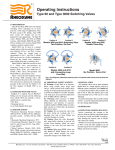
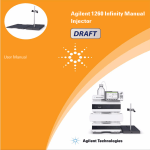
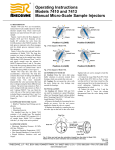
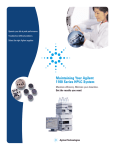

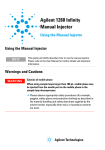
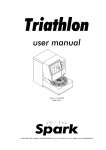
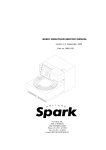
![TSQ Series Getting Started Guide Version C [FR]](http://vs1.manualzilla.com/store/data/006357565_1-ae930521dae4517a45cdbc191dde2ba3-150x150.png)
